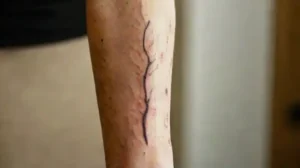Getting body art, such as tattoos or piercings, can be an exciting experience, but for individuals with sensitive skin, it often involves concerns about discomfort and adverse reactions. Many people worry about increased pain levels and possible skin irritation, which can make the process more stressful. Proper pain management strategies are essential to ensure a safe and comfortable experience for those with delicate skin types.
Understanding how sensitive skin reacts during body art procedures is crucial for proper preparation. With the right techniques and skincare practices, individuals can minimize discomfort and reduce the risk of complications, making their body art journey more enjoyable. Educating oneself about suitable pain control options is a vital step toward a positive outcome.
Consult with a Professional Before the Procedure
Before undergoing any body art, it is important to consult with a qualified professional. An experienced artist or dermatologist can assess your skin’s sensitivity and recommend personalized pain management techniques. This consultation helps identify potential obstacles before the procedure begins, ensuring safer outcomes.
Be honest about your previous experiences with skin reactions or pain. This information allows the artist to tailor their approach specifically for sensitive skin, possibly suggesting alternative techniques or protective measures. Clear communication with your provider is essential for setting realistic expectations and preventing unnecessary discomfort.
Prepare questions regarding pain relief options and skin care during and after the procedure. A professional can provide guidance on suitable topical anesthetics or soothing remedies to minimize pain and irritation. Knowing your options helps you make informed choices and feel more confident during the process.
Choose the Right Tattoo or Piercing Artist
Selecting a skilled and reputable artist is critical, especially for sensitive skin. An experienced professional will use proper sterilization techniques and gentle practices that minimize trauma to the skin. This reduces the likelihood of excessive pain and subsequent inflammation.
Ask the artist about their experience working with sensitive skin types. A knowledgeable artist can recommend specific needle sizes, ink types, or piercing techniques that lessen discomfort. Their expertise can make the entire procedure smoother and less intrusive for delicate skin.
Review previous client testimonials or portfolio photos to gauge their ability to handle sensitive skin cases. Feeling confident in your artist’s ability can greatly reduce pre-procedure anxiety and help you attain a more comfortable experience overall.
Use Topical Anesthetics Effectively
Topical anesthetics are commonly used to numb the skin before body art procedures, providing significant pain relief. For sensitive skin, choosing the appropriate product and applying it correctly is especially important. Consult with your artist or dermatologist to select the best option for your skin type.
Apply the anesthetic in accordance with the recommended guidelines and timing to achieve optimal numbing effects. An overly thick or improperly timed application can reduce the medication’s efficacy or cause irritation. Proper usage ensures maximum comfort during the procedure.
Be aware of potential allergic reactions to anesthetic ingredients. Conduct a patch test prior to the procedure if you have any known sensitivities. This extra step can help prevent adverse reactions and ensure a safe, pain-free experience.
Incorporate Relaxation and Breathing Techniques
Managing anxiety is crucial for reducing perceived pain and making the procedure more tolerable. Techniques such as deep breathing, meditation, or guided imagery can help you stay calm throughout the process. These practices slow your heart rate and promote skin relaxation.
Practice these techniques beforehand and during the procedure to maintain a state of calmness. The more relaxed your body and mind are, the less likely you are to experience heightened discomfort or skin tightness, which can make the process more painful.
Communicate with your artist if you feel overwhelmed or anxious at any point. Taking short breaks or employing additional relaxation strategies can make a significant difference in your overall comfort level.
Take Care of Your Skin Before and After the Procedure
Proper skincare before the procedure can prepare sensitive skin for less trauma and reduce pain. Keep the skin well-hydrated and avoid harsh chemicals or exfoliants in the days leading up to your appointment. This creates a healthier, more resilient skin surface.
Post-procedure, follow your artist’s after-care instructions carefully. Using soothing and fragrance-free moisturizers can help minimize irritation and promote healing. Proper care prevents excessive itching or redness that may intensify discomfort.
Avoid sun exposure and harsh environments immediately after body art. Protecting your skin from external stressors helps prevent excessive irritation and preserves the integrity of the artwork. Consistent skin care supports a more comfortable recovery process.
Consider Alternative Pain Management Options
If topical anesthetics alone are insufficient, discuss alternative methods with your provider. Options such as nerve blocks or oral pain relievers might be appropriate depending on the procedure’s extent and your skin’s sensitivity.
Combining different pain relief techniques can enhance overall comfort, especially for those with heightened skin reactivity. Your healthcare professional can recommend safe options that suit your specific needs and minimize side effects.
Always prioritize safety and consult professionals before using any medications or invasive pain management tools. Proper guidance ensures you’s pain is effectively controlled while protecting your delicate skin from unnecessary damage.
Managing pain and irritation for sensitive skin during body art requires careful preparation, expert support, and mindful practices. By choosing experienced professionals, utilizing appropriate topical anesthetics, and employing relaxation techniques, individuals can significantly improve their comfort level and overall experience.
Taking proactive skincare measures before and after the procedure is also vital in minimizing discomfort and promoting better healing outcomes. With the right approach, those with sensitive skin can confidently enjoy body art without unnecessary distress or complications. Prioritizing safety and personalized care will help ensure a positive and memorable experience.







